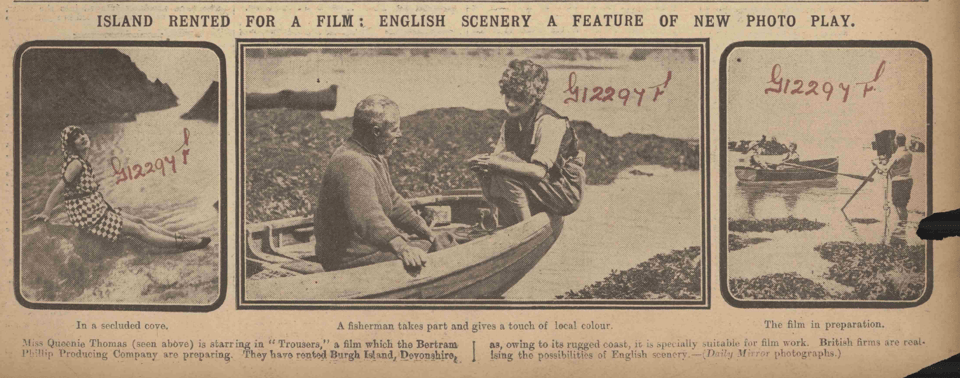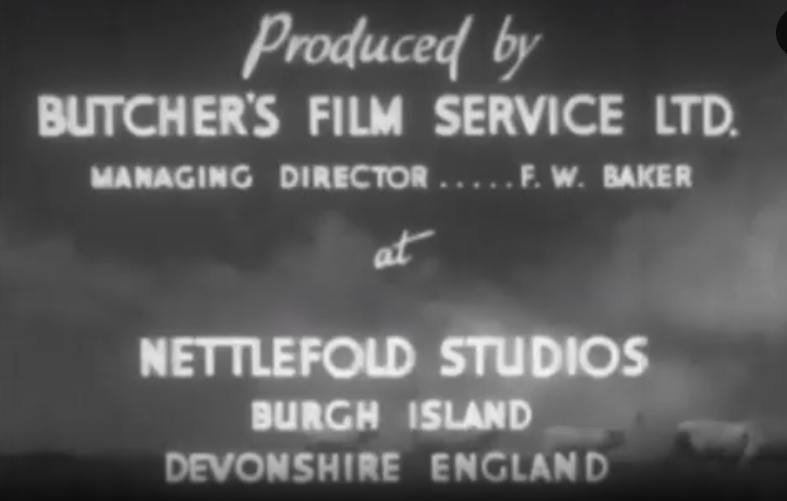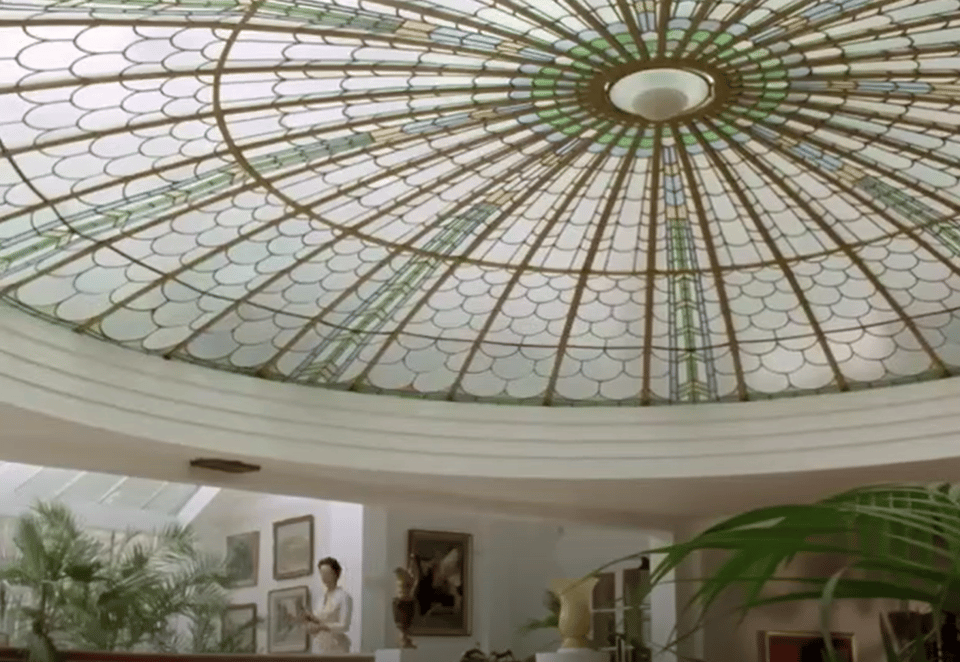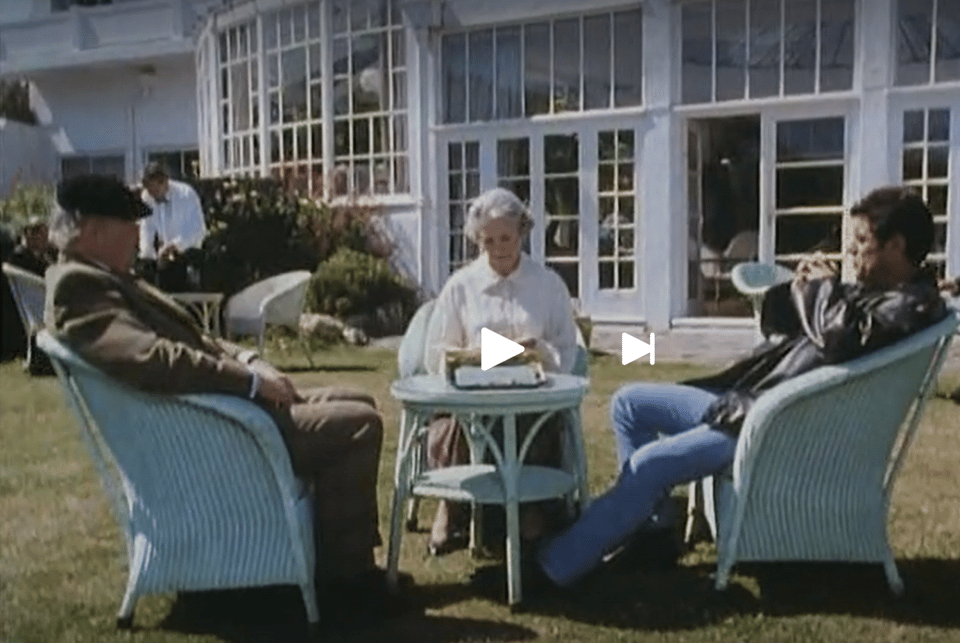Burgh's on film
All the drama films and TV filmed at Burgh Island, from 1919 to 2025.
When I started researching Burgh Island Hotel for my deep dive, I didn’t expect to find much as it’s a well-trodden path. I actually ended up with a lot of material that suggested the story told of the building’s history doesn’t match the contemporary secondary sources. That meant some early material on the island’s appearances on film were left on the cutting room floor.
This list captures the times the film or tv crews went to Burgh to make drama, in chronological order.
Trousers (1920)
In August 1919, British film star Queenie Thomas lived on Burgh Island for a month along with a film crew. They stayed in the getaway home of George Chirgwin, a musical hall star. He’d bought the island in 1914 and built a wooden “chalet style” 12-bedroom house on it. Queenie was there to make the silent film Trousers.

Directed by Bertram Philips, the film was released in 1920 and may be the only footage of the island before the hotel was built. The film appears to be lost. Philips’ 1920s films, such as School for Scandal (1923), were distributed by Butcher’s Film Services. Butcher’s distribution list also included a lot of films made at Nettlefold Studios at Walton on Thames.
Nettlefold Studios was formed in 1926 by Archibald ‘Archie’ Nettlefold. Three years later, Archie bought Burgh Island to build his hotel on. It’s tempting to imagine Queenie Thomas and Archie Nettlefold at a cocktail party with their mutual contacts and someone saying “Did you hear? That darling little island of Chirgwin’s is for sale…”
Sheepdog of the Hills (1941)
By 1941, there were no darling little cocktail parties. Nettlefold Studios had decamped to Burgh Island, where Archie’s luxury hotel became their filmmaking base. In practice they made just one, with distribution by Butcher’s Film Services.

There are no shots of the hotel, though some buildings look like the neighbouring Pilchard Inn. You can find the whole thing online. It’s a typical British second feature; little more than a quota quickie.
Archie’s plans for Nettlefold Studios in Devon were derailed in 1942, when a high explosive bomb took out the northern wing of the hotel. By the end of WW2 Archie was dead and Burgh Island had been sold on.
Catch Us If You Can (1965)
Burgh Island went through several changes of owner in the early 1960s, and it’s possible coverage of this caught the eye of writer Peter Nichols or director John Boorman. They were both based in Bristol at the time, and used locations they knew to make Boorman’s first feature. Catch Us If You Can is the first film to really make use of Burgh Island and the hotel as itself.

Dinah is considering buying the island as a way to escape her fame. She makes a run for it with stuntman Steve, only to discover it smells of “dead holidays” and is only an island at high tide. It’s an enjoyable film that uses its locations with purpose.
The ownership of the island had settled down by 1975. That’s when EMI Films announced they would be adapting Evil Under the Sun, Christie’s 1941 Poirot novel which uses the island’s geography as inspiration. Producers Richard Goodwin and John Brabourne apparently visited but declined the owners’ suggestion to film there.
The producers of a Kirk Douglas film were interested though.
Holocaust 2000 (1977)
Douglas came to Burgh to film parts of Alberto de Martino’s Italian schlock horror, Holocaust 2000.1 A film absent from modern write-ups of the hotel’s appearances on film, even by its other names as The Chosen and Rain of Fire.
Burgh Island acts as the hideaway for one of the characters, with Kirk Douglas confronting him on the sands. And then…the tide comes in. The implication is the devil has drowned the other character. Which seems odd, given the tides come in twice a day and you can walk ashore to avoid them.

I have to admit, I watched this on double-speed just to find the relevant scene.
Miss Marple: Nemesis (1987)
The newly repaired and refurbished palm court acts as La Rocheverte, the home of millionaire Jason Rafiel. He sets things rolling so that Nemesis, the goddess of retribution, will bring about justice. Nemesis in this case taking the form of Miss Marple.

I will admit that I adore the Joan Hickson Miss Marple adaptations and always have. That the Porters successfully sold the hotel as a film location, within a year of getting the keys is a sign of their determination to save the hotel.
Lovejoy: Somewhere Over the Rainbow (1994)
The Porters excelled at getting income from film crews. This TV episode of Lovejoy does more than use the building as a set: all the stories and myths of Burgh Island are woven into the plot. ‘Tink’ is revealed as the brother of the owner, one Olive Nettleton.

A fun little romp that really shows off the island.
Poirot: Evil Under the Sun (2001)
Peter Ustinov never used his little grey cells at Burgh Island but by the time LWT came to adapt the novel with David Suchet, the hotel was ready for their close up. The exteriors are stunning.
The whole film is available on the ITV player.
The interiors do not quite match the current hotel, but are also sufficiently close that if they are a set they are based on the building.
Nightwalk (2013)
This 6 minute short by Scott Barley could have been filmed anywhere along a coast, but was filmed at Burgh. It uses a night camera and no dialogue to follow a girl along a cliff.
Towards Zero (2025)
Burgh Island Hotel stands in as Easterhead Hotel in this adaptation. It’s very much in the style of the current Christie adaptations.
A key plot element is whether it is possible to swim across the bay and how dangerous it is. In looking through local press coverage of Burgh Island, I found that this was sadly true. Until Bigbury beach started to have lifeguards, no decade was without a drowning. Another piece of Burgh Island history Christie used?
If you’re aware of another film or TV drama that features Burgh Island, please let me know and I’ll add it to the list.
You can read a list of recent non-fiction TV appearances on the Burgh Island Hotel website.
Top Hollywood film star filming in South Devon, Torbay Herald Express, 31 May 1977 ↩